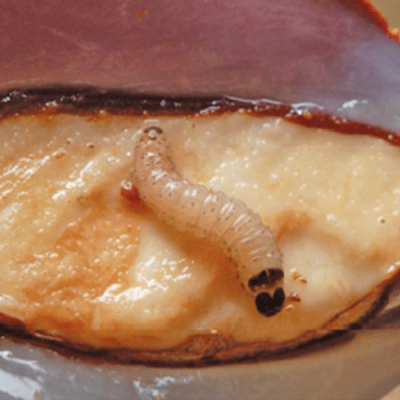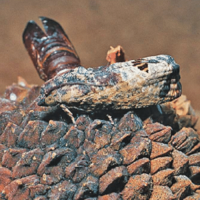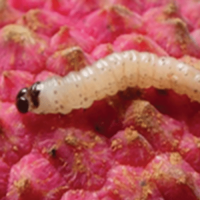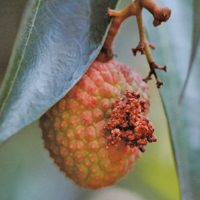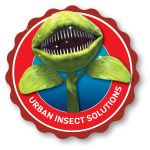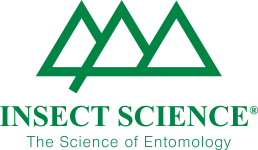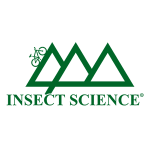Host plants
Cryptophlebia petastica is polyphagous and of economic importance on litchi and to a limited extent on macadamia nuts in southern Africa. Other known hosts include jacket-plum, Pappea capensis (Sapindaceae); pods of Karoo boer-bean, Schotia afra (Caesalpiniaceae); flamboyant, Delonix regia (Fabaceae); and pride-of-De Kaap, Bauhinia galpinii (Caesalpiniaceae). Crytophlebia peltastica also forms part of the Lepidoptera assemblage in galls of Ravenelia macowiana (Urendinales) on Acacua karroo, as well as the galls of Uromycladium tepperianum (Urendinales) used for the biological control of the invasive Port Jackson willow, Acacia siligna.
Damage
The rate of oviposition by this moth is low during the early stages of fruit development but increases as the fruit ripens. The newly hatched larva penetrates the litchi fruit and feeds its way through the fruit flesh and into the seed (illustrated). Such feeding facilitates fungal growth and other infestations leading to fruit rot. Larval activity is detected by the presence of brown granular excrete on the fruit surface, as illustrated.
Litchi moth together with the false codling moth, is of considerable economic importance on litchi. In addition, both these moths are of quarantine importance and indirect losses result from quarantine restrictions imposed by importing countries, to prevent entry and the possible establishment of unwanted moths. A survey conducted during the 2003/2004 season in the Mpumalanga Province of South Africa indicated that the level of infestation varied between 0-5.8%, while a survey conducted during the 2004/2005 season indicated that the infestation level varied between 0-12%. In Mauritius, infestation levels can reach up to 20% (Manrakhan et al., 2008).
Life history
The life history of this indigenous moth has not been studied in any detail. The moth lays her eggs singly on the fruit, rarely on the leaves. On hatching, the larva feeds on the fruit skin and then tunnels towards the seed. Larvae usually do not pupate in the fruit on the tree but leave fruit to pupate in the soil. If infested fruit is stored for a long period after harvest, the pupal case can be seen protruding from the fruit. The duration of the different life stages is not known.
Natural enemies
Moth eggs on litchi in South Africa are known to be parasitized by an unidentified trichogrammatid wasp of the Trichogrammatoidea (Newton & Crause, 1990). An Ichneumonid wasp parasitoid in the subfamily Campopleginae has been recorded from Mauritius (Manrakhan et al. 2008).
Management
Cryptophlebia peltastica can be monitored using para-pheromones in litchi orchards. Two chitin synthetic inhibitors, namely teflubenzuron and triflumeron are registered for the control of months on litchi. Teflubenzuron must be applied when, or just before, fruit reach a diameter of 10 mm. A second application can be applied two weeks later if fruit are destined for the export market. Triflumeron must be applied 40 days before expected harvest. According to Newton & Crause (1990) augmentative releases of trichgrammatid egg parasitoids early in the season may present an alternative to chemical control. On litchi, covering the fruit with paper bags offers protection against moths and other pests; bags must be tied around the fruit clusters after the end of premature fruit abortion, also known as November drop. The bags should remain around the fruit until harvest. If other host plants of C. peltastica, such as macadamia nuts occur in the same vicinity as litchis, it is imperative to apply orchard sanitation in the macadamia stands.

